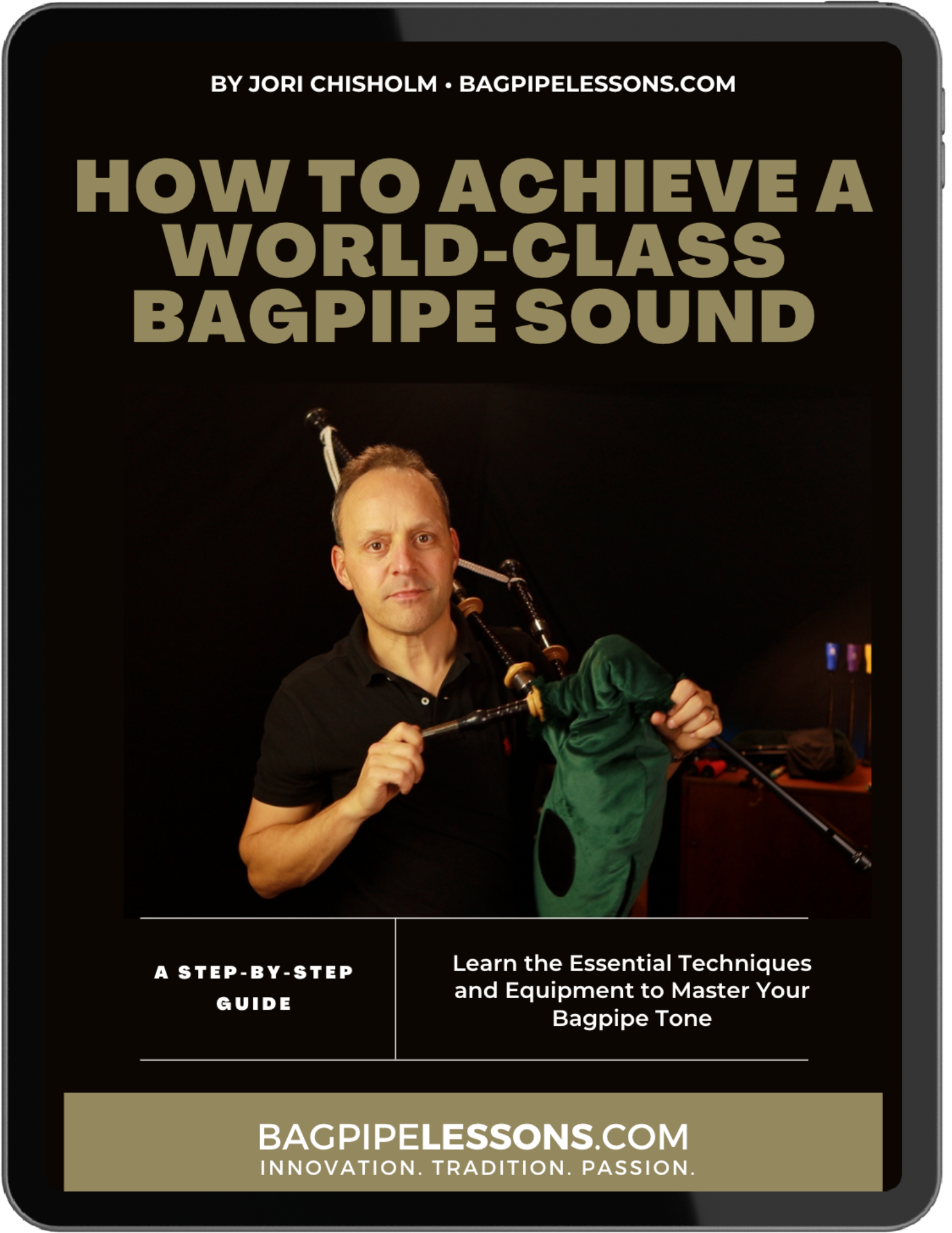
AS FEATURED IN

What’s in the Box? First Look at NEW R.G. Hardie & Co Stunning Blackwood Bagpipes
by Jori Chisholm, Founder of BagpipeLessons.com
Last Updated: April 11, 2025
Something very special arrived at my doorstep today—a brand new set of R.G. Hardie O2AB bagpipes from Scotland! These Blackwood pipes are absolutely stunning, featuring beaded and capped nickel ferrules, beautifully machined drone stocks, and innovative moisture-resistant design.
In this unboxing video, I’ll take you through everything included in this “sticks-only” set and share my thoughts on the craftsmanship, materials, and unique features that make this an exceptional choice for any piper:
- R.G. Hardie O2AB Blackwood Bagpipes – Featuring stunning beaded and capped nickel ferrules.
- R.G. Hardie Deluxe Pipe Case – A high-quality, stylish, and functional bagpipe case.
- Black Corduroy Pipe Bag Cover – A sleek and non-slip cover for added grip and protection.
- Blowpipe with Plastic Liner – A smart hybrid design that prevents moisture-related cracking.
- Blowpipe Stock with Plastic Lining – Protects against moisture buildup inside the bagpipe stock.
- Drone Stocks & Drone Sections – Perfectly machined for airtight fit and smooth tuning.
- Chanter Stock – Ready for installation with your favorite chanter.
I’ll also discuss how I’ll set these up for a customer with a Bannatyne Hybrid Pipe Bag, Ezeedrone Combo Reeds, and a Tone Protector for ultimate stability and sound quality.
Key Points
- 📦 Exciting Delivery from Scotland – A new set of R.G. Hardie & Co. bagpipes has arrived, shipped quickly from Scotland.
- 🎒 Deluxe Bagpipe Case – A well-made, backpack-style case with compartments for maintenance supplies and sheet music are included.
- 🥢 Bagpipes: Sticks-Only Set – The set includes essential parts but needs a bag, reeds, and cords to be playable.
- 🌳 African Blackwood – The pipes feature intricate combing and beading, with durable synthetic ivory alternatives.
- 💨 Moisture-Resistant Blowpipe – Designed with a plastic-lined core to prevent cracking from breath moisture.
- 🔧 Precision Engineering – Modern bagpipes benefit from advanced machining for consistency and durability.
Video Transcript: Hey everybody, Jori Chisholm here from BagpipeLessons.com. I was not planning on making a video today, but something very special arrived at my doorstep from Scotland, and I thought it’d be fun to throw on the camera and let you enjoy this moment with me—one that I always enjoy—which is opening up a new set of bagpipes!
These came from R.G. Hardie in Scotland, and they got here really fast. Let’s take a look.
Now, many of you who have been following my YouTube channel know that I’m a huge fan of R.G. Hardie products in general, but especially their Infinity pipe chanter, which is my favorite pipe chanter. It has smaller holes and closer spacing, plus an amazing sound. And of course, I’m a huge fan of their practice chanters—especially the practice chanter that I designed and that they make for me, the Endurance Practice Chanter, which has a built-in moisture control system.
R.G. Hardie is famous around the world for making bagpipes, and that’s what we have here today.
With every shipment, you get a delivery note that says what’s included. This one says:
- A set of R.G. Hardie 02AB bagpipes (sticks only)
- The deluxe piper case in gray
- A black bag cover
They do a really nice job of packaging things up—plenty of bubble wrap.
Here we have the very cool R.G. Hardie deluxe case. I love this case—it’s backpack-style, really well-made, with lots of compartments for all your various maintenance supplies. There are little zipper pouches in here, all kinds of great storage. It’s big enough to fit some sheet music, maybe even a three-ring binder or a folder. There’s another pouch, more storage spots, velcro, zippers for your brushes, reeds, Bagpipe Gauge, pokers—all that good stuff. Very well-made and cool-looking, too. It comes in different colors, but I think this gray color looks really nice. Let’s open it up and see what’s inside.
Here we go. All right, we’ve got the bag cover in black corduroy with the dimple patch, which is very important for the non-slip grip. It’s got a zipper on the bottom. Once I assemble the pipes, I’ll be putting this cover on. Very nice.
I’ll put that to the side.
More bubble wrap. When you get a set of pipes that are “sticks only,” it means they come without a bag, reeds, or cords. You can buy bagpipes fully set up or as sticks only. If you’re new to bagpipes, here’s what’s included in a sticks-only set:
- Three drones (one bass drone and two tenor drones)
- A blowpipe
- Five stocks
That’s the minimum of what makes up a set of bagpipes. In this state, they’re not playable yet—you still need to add a bag, reeds, drone cords (to hold the drones together), and a pipe chanter.
A lot of pipers who play older pipes, or pipes they’ve had for decades, will change everything except the sticks. The bag, reeds, and even the pipe chanter are all replaceable. Think of reeds like tires or filters on a car—things that need to be swapped out every few years. Many sets of pipes come with a chanter, but pipers often switch chanters throughout their careers because new designs keep improving. They become more comfortable to play, have a great sound, and provide that bright, efficient, projecting tone we love.
Even pipers who play 100- or 125-year-old bagpipes often use modern pipe chanters.
When you get sticks only, they should be individually wrapped—like these are—so they don’t get damaged in shipping. It’s not enough to just have them in a case; you want each part separated to prevent them from banging into each other.
Let’s unwrap them. These are very well packed.
I’m setting up these pipes for a customer who wanted a great-sounding set with a particular look. These pipes are made of African Blackwood with combing and beading—that’s the traditional decorative style. The little lines you see are called combing, and the smooth areas in between are called the beads.
This part here is called the projecting mount. A lot of pipes have lighter-colored mounts—historically, they were made from elephant ivory. Today, most bagpipes use imitation ivory because real ivory is hard to get, expensive, prone to cracking, and, of course, we don’t want to harm elephants.
Instead of imitation ivory, these mounts are made of African Blackwood, the same material as the rest of the pipes.
These metal rings here are called ferrules. They’re nickel. A ferrule is a metal band used to hold the pipe sections together—just like the little metal piece that connects an eraser to a pencil.
At the top, we have the caps—this is the top of the bass drone.
Let’s keep unwrapping.
This reminds me of a time I ordered vintage drinking glasses online. When the package arrived, I picked up the box and immediately heard the sound of broken glass inside. The seller had done a great job wrapping the box itself, but inside, the glasses were touching with no padding between them—so they all shattered during shipping.
That’s why, when shipping bagpipes (whether new or used), every piece needs to be individually wrapped—just like these.
Here we have the blowpipe and blowpipe stock. The blowpipe is actually the most likely part of a bagpipe to crack.
Cracking usually isn’t from physical damage—it’s from moisture. When moisture from your breath condenses inside the blowpipe, the wood soaks it up and swells, which can cause it to split.
R.G. Hardie has come up with a great solution: the exterior of this blowpipe is beautiful African Blackwood, but the interior is plastic. The part where the moisture collects is completely sealed off from the wood, so it’s never going to crack. Same with the blowpipe stock—the part inside the bag is plastic. It’s a fantastic blend of traditional aesthetics and modern durability.
Now, here’s the bottom section of the bass drone.
Once I get these pipes set up, I won’t be filming a setup video this time, but I have other videos on my channel that go over the process. There’s a two-part series called “Build Your Bagpipes,” where I go step-by-step through assembling a set. I also did a live stream where I built a set in real time.
The bass drone has three sections: bottom, middle, and top. When you tune, you move the sections up and down. The stock goes into the bag, and the drone reed sits in the bottom.
Here it is all together—just beautiful. From the shiny nickel caps to the combing and beading, it looks fantastic. These ferrules are beaded and capped, meaning the metal extends around the bottom for a finished look. Some ferrules are just tubes of metal without the cap.
Let’s check the tenor drones—identical to each other, just like the bass drone but with two sections instead of three.
Looking inside, they’re extremely smooth and well-machined—absolutely perfect.
That’s the benefit of modern bagpipe manufacturing. While there are great old pipes out there, not all older sets were made with the same precision. Over time, wood can warp or crack. Modern makers like R.G. Hardie combine traditional craftsmanship with advanced tooling to ensure a perfect result.
Here’s the last piece: the chanter stock.
So that’s the full set—R.G. Hardie 02AB bagpipes. The “AB” stands for African Blackwood. These aren’t plastic; they’re real wood. The 02 model features nickel ferrules, beaded and capped, with beautiful African Blackwood projecting mounts.
Once fully assembled, this set will have a Bannatyne hybrid pipe bag, a Willie McCallum-style black drone cord, a black-on-black bag cover, and amazing Ezeedrone reeds.
I wasn’t expecting to film today, but I wanted to share this with you!
If you’re interested in getting a set of bagpipes, reach out to me through my website, BagpipeLessons.com. I have pipes for sale and will be adding more options soon. I also recently spoke with Alastair Dunn at R.G. Hardie, and they’ve got some exciting new products coming out.
Thanks for watching! If you enjoyed this video, subscribe to my channel and hit the bell to get notified about new videos.
Happy piping!





